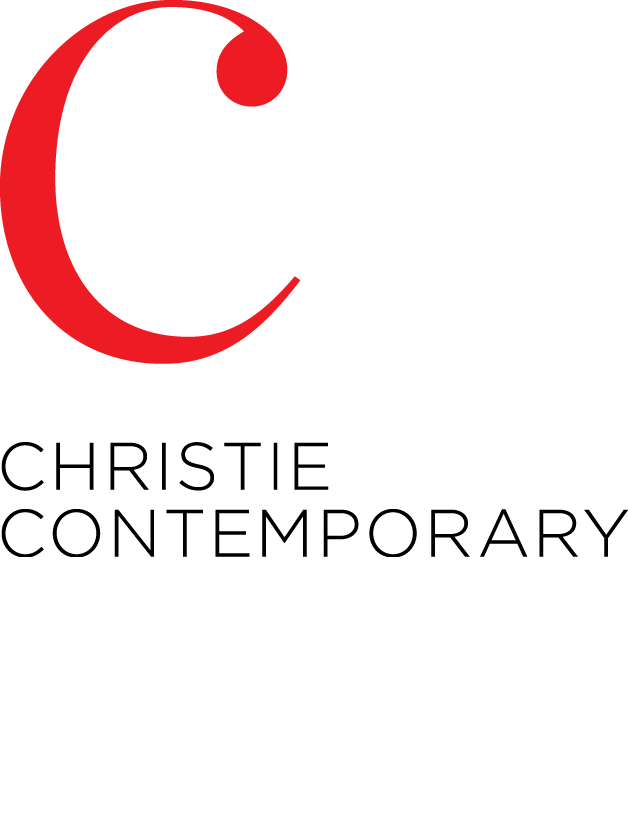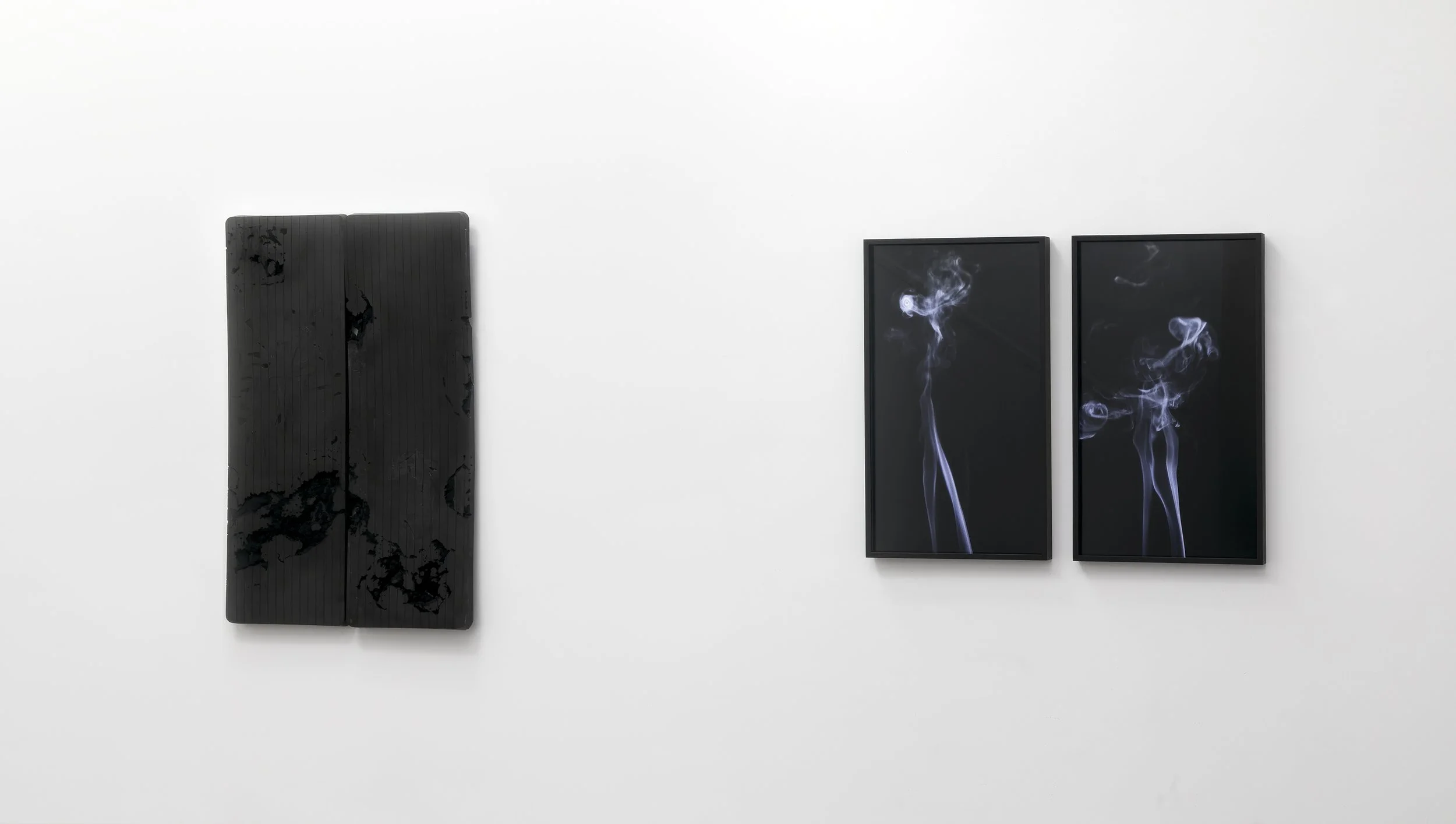YAM LAU Creature 2023, diptych; layered digital prints, edition 1 of 2, 20.75 x 17.75 inches each
JADE RUDE Remnants of You and Me, 2024, diptych; offcuts from handcut 3mm wool felt, 21 x 16.75 inches each [framed]
While the term “pair” immediately suggests a bond, it also implies a division between two things. For the artists in this exhibition the dividing line invites a reading, not of the individual parts, but the condition of their entanglement. A quality of resemblance occurs within all of the works, as the almost-double, the echo. Set side by side, two proportionally equal parts inevitably provoke comparison, but scrutiny reveals difference. This difference, whether pronounced or incremental, emerges as the tether between the two elements, and a contemplation of the strategies that determined their combination.
For Nick Ostoff, the diptych is a structure that complements his often iterative approach to painting, where the image in a single found photograph might populate an entire exhibition, with different versions cueing the temporal through adjustments to light in a given scene. The found photograph that launched his series Roundabout was already a fragment that alluded to a whole. With Roundabout (colour source mirror diptych), Ostoff suggests the whole by mirroring the image fragment to complete the scene. While the completed circle in the two images initially suggests a unified whole, its eccentric presentation and reflected view instead effect a ponderance of loss, an eclipsed presence repaired in the illusory space of the doubled.
Sarah Elise Hall also forwards a suggestion of loss in her lozenge-like ebony slabs. Abutted to one another, the marble slabs of Hall’s diptych speak to both erosion and ecological threat. Each slab is cast from the same salvaged container (here, a planter tray), revived as a ready-made mould. Hall will cast from the same container multiple times, each resultant ‘slab’ replicating the subtle industrial contours of the chosen plastic form, punctuated by instances of erosion and pulverization achieved through her organic casting method and choice of constituent material (mineral pigment, porcelain powder, marble dust, binder). Using mineral pigments and embedding sites of erosion, Hall’s dense, marble slabs allude to the earth’s geologic record, one that without correction may, as her casts eerily suggest, ultimately host the accumulated sediment of fossilized plastics.
Kelly Mark’s Smoke Buddies 1+2, a photographic diptych comprising stills from a video of the same name, pictures plumes of smoke meandering upward in each frame, set against a black ground. The video work recorded (in a somewhat accidental fashion) the smoke from a pair of cigarettes off-camera. The quality of the stills gives a slightly murky violet-blue hue to the expiring tobacco, lending an atmospheric, temporal aspect. Taken from different moments in the time-based work, the fine tendrils of smoke bear similarity, yet at the same time also speak to the impossibility of their duplication.
Yam Lau’s diptych, Creature, is a transformative figure, represented across two frames. The images comprise the Chinese characters (stacked and overlaid) from the first lines of A Free and Easy Wandering — the first chapter of the foundational Chinese Taoist writing of Chuang Tze. It is a text that describes the constantly varying dimensions and forms of a mythological beast, noting the inadequacy of language to relate such a description. Lau subtly codes the work, printing to a gridded paper to underscore the incalculable scale of the described creature, and shifting the colour underneath to relate movement. While the text is rendered illegible on the one hand, its compressed configuration manifests as an emergent form — perhaps an image of the indescribable creature written.
Larissa Tiggelers’s painting, two-folding over, presents as two distinct halves. This vertical bisecting of the picture plane, rather than rendering them distinct and separate, binds them in a hide-and-seek game of elusive similarity, as their not-quite-mirroring and slippery symmetries act upon the viewer. As Blair Fornwald writes, “Doubling invites the outside in. It amplifies theatricality by suggesting a performative interplay between the two entities. [...]. Their compositions appear to fold and mirror each other, not only along the vertical axis—a strategy Tiggelers has established throughout this body of work—but also along horizontals and diagonals, inverting, flipping, and swapping pieces back and forth across numerous divides.”
Jade Rude’s work, Remnants of You and Me, uses the offcuts from textual felt sculptures as working material. Rude determined that “what is left” retains some potency, and carefully preserved the remnants generated by the excised letters Y-O-U and M-E. The literality of the title in this instance, Remnants of You and Me, equally relates a wistful intonation, as though mourning the end of a relationship, with the divide between the framed remnants separating them, but also binding them together in perpetuity. Materially, each frame contains the residue of language, an afterword of sorts — that observation that comes at the end of a text, that only reveals itself on finishing the act of writing.
SARAH ELISE HALL Striated Black Carbon Slab, 2021, diptych; marble dust, porcelain powder, mineral pigment, glass, eco resin, 45 x 28.25 x 1.75 inches
KELLY MARK Smoke Buddies, 2017, diptych; pigment ink on archival rag paper, edition of 3 32.75 x 18.75 inches each
Kelly Mark’s work appears courtesy the Estate of Kelly Mark and Olga Korper Gallery.
NICK OSTOFF Roundabout (colour source mirror diptych), 2017, diptych; oil on paper, oil on canvas, 20x26 [framed] and 15 x 22 inches
LARISSA TIGGELERS two folding over, two-folding over, 2024, acrylic on canvas, 46 x 36 inches




